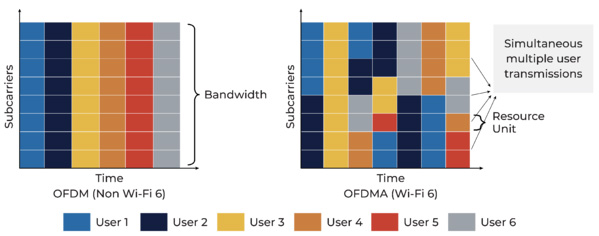Traditionally the Wi-Fi standards have focused on improving peak throughput and capacity. While the latency in prior Wi-Fi standards has been typically low, it becomes excessive and non-deterministic in dense deployments such as airports, hotels, stadiums, multi-dwelling apartments, etc.
The emerging applications such as tele-health, Virtual Reality (VR), online/multi-player gaming, industrial control, logistics, robotics, stereo/multi-speaker audio, and other time critical IoT applications require predictability and low latency. Many IoT applications need to support a large number of devices in a small area leading to severe congestion which in turn can lead to increased collisions and variable latency.
Reduced and deterministic latency is a key design feature of Wi-Fi 6. It achieves this by using Orthogonal Frequency Division Multiple Access (OFDMA) at Physical layer and other enhancements at Medium Access Control (MAC) layer.
Older generations of Wi-Fi allow any device in a network to initiate transmission at any time with minimal coordination. While this approach works well in lightly loaded networks, in dense deployments it is very inefficient due to packet collisions. In Wi-Fi 6, OFDMA adopts centralized coordination by an Access Point (AP) to manage transmission and reception to and from non-AP devices. This improves the efficiency of transmission and therefore reduces average latency. It also limits worst case latency.

Statistically, in the uplink transmissions (towards an AP), 80% of the packets are 100 bytes or less. Traditional Wi-Fi standards allow transmission by only one device at a time whereas OFDMA in Wi-Fi 6 enables transmission by multiple devices simultaneously which is especially well suited for small packets. This reduces the worst case latency significantly.
Dynamic Overlapping Basic Service Set Packet Detection (OBSS-PD) is another feature of Wi-Fi 6 that reduces the latency variation. OBSS-PD essentially enables the devices in one BSS to ignore transmissions from another nearby BSS which may be using the same channel. All the BSSs in the overlapping set get the benefit of reduced latency.
Summary:
If you are developing an application that needs low latency, you should consider moving your connectivity to Wi-Fi 6 sooner rather than later!
Learn more about the reasons to move to Wi-Fi 6.
News & Additional Resources
Page Jul 6, 2022 |


